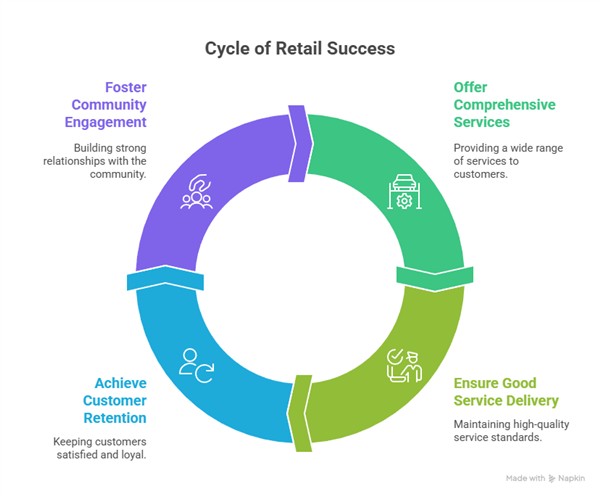
A successful bicycle retail shop in Keysborough closed after many years of serving the cycling community. I think it reveals a critical lesson about retail that data without context can destroy a business.
The shop had served the local cycling community for many years, operating as a traditional full-service bicycle retailer. The business offered a comprehensive service workshop for mechanical repairs and servicing, as well as entry-level bicycle sales, accessory retail, and upper-end bikes. While the operation exhibited some management disorganisation, it demonstrated strong customer retention through consistent good service delivery, resulting in excellent community engagement.
Retail Analytics Transformation
The business underwent digital transformation many years before closure, implementing our POS Systems with its specialised bicycle retail POS software. This decision represented sound strategic thinking, as the system was designed explicitly for bicycle retailers, incorporating advanced inventory tracking, sales analytics, and customer relationship management functionality. It all should have been used. For this particular shop, the POS system effectively provided a detailed analysis of profit margins across product categories and service offerings. It established a solid analytical foundation for the business.
Then, a long-term employee with extensive operational knowledge in the business took ownership of the company. He did a comprehensive analysis of financial data and sales performance metrics, facilitated by our POS system's reporting capabilities. It revealed significant insights regarding profitability structures; unfortunately, he only examined the financial reports.
The analysis demonstrated that repair services generated minimal profit margins. Labour costs were relatively high; industry average profit margins are around 20% if you decide to outsource them. Also, due to competitive pressure from large retailers, budget-oriented bicycles targeting casual riders and kids showed limited profitability. Premium bikes were doing well. Determined to enhance business performance, the new owner implemented a comprehensive strategic change. He abandoned the existing broad market appeal in favour of an exclusive focus on premium bicycle segments featuring high-end brands. You can see the advanced carbon frame technology and sophisticated gearing systems in the shop, all with price points of thousands of dollars.
However, having powerful analytics capabilities means nothing without understanding how to interpret them within the shop context, a lesson this shop never learnt.
Implementation of Strategic Changes
The business transformation involved the complete elimination of repair services, a decision that significantly impacted established customer relationships. Regular service customers, like me, were redirected to alternative repair shops, effectively severing ongoing maintenance relationships that had previously anchored our customer loyalty. At the same time, they discontinued entry-level bicycles, actually heavily discounting existing stock to clear them out.
This strategic repositioning aimed to capture premium market segments comprising serious cycling enthusiasts prepared to invest substantially in high-quality equipment. However, the changes created substantial operational consequences.
The elimination of repair services created a domino effect that destroyed the business model. Regular customers like me stopped visiting entirely, resulting in a significant decline in foot traffic. This loss proved devastating for accessory sales. Repair customers like me typically make impulse purchases, such as helmets, lights, and tools, generating higher-margin revenue streams. Without these frequent visitors, the shop lost both immediate sales and cross-selling opportunities that had sustained profitability.
These operational changes, while data-driven, completely ignored the fundamental characteristics of the local market.
Market Analysis and Customer Demographics
Keysborough represents a suburban demographic characterised by family-oriented priorities and value-conscious purchasing behaviour, rather than premium luxury consumption patterns. The local market traditionally favoured practical, affordable bicycle solutions for family requirements, particularly initial bicycles for young riders, rather than professional-grade equipment.
The strategic pivot fundamentally misaligned the business offering with local market characteristics. Family customers who previously engaged regularly for affordable bicycle purchases and associated accessories discontinued their patronage. This demographic shift eliminated not only immediate sales opportunities but also potential long-term customer development pathways, as these families might have eventually upgraded to higher-value products through established relationships and demonstrated product quality.
The business model transformation severed these developmental customer relationships, eliminating opportunities for gradual up-selling and loyalty building that typically characterise successful retail operations.
Business Performance Analysis and Strategic Implications
Following the implementation of the strategic changes, business performance declined rapidly. The premium-focused approach proved incompatible with the local market environment, where economic realities prioritised accessibility over exclusivity. Customer traffic dropped, inventory turnover slowed, and the once-busy shop was pretty quiet.
The shop closed and is now for lease. While profit margin analysis provides essential advice, retail success needs more than that.
Strategic Recommendations
Effective retail management strikes a balance between quantitative analysis and market understanding. Modest-margin products often act as customer acquisition tools. Those repair services and entry-level products served as gateway offerings.
Successful retail operations require a comprehensive understanding of customer behaviour patterns, community characteristics, and relationship dynamics.


